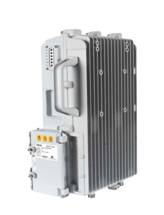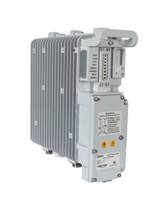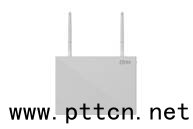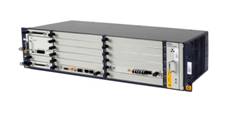|
1. BBUs:B8200、B8300
As multi-mode compact BBUs, B8200 and B8300 mainly provide S1/T1/X2 interfaces, clock synchronization interfaces, and RRU digital baseband interfaces and implement exchange of internal services and communication data. An RRU is connected to a BBU by using digital baseband signal fibers.
B8200 B8300
Product Highlights
-
MicroTCA-based open architecture, supporting third-party AMC and PrAMC modules
-
High integration, good system compatibility and scalability, small volume, and antivibration design
-
Flexible and abundant interfaces, supporting clock synchronization modes such as GPS, GLONASS, BeiDou Navigation Satellite System (BDS), and IEEE1588V2
-
Environmental protection and low power consumption
-
Support for DC/AC power supply and flexible installation
-
High reliability
The main control board and power supply both work in 1+1 backup mode or load balancing mode. All boards and modules are hot swappable. Maintenance, detection, fault rectification, and software download can be completed remotely.
2. RRU:R8972E
As a TD-LTE dual-channel RRU, R8972E works on 1.4 GHz frequency and is mainly deployed in a macro-cell networking.

Product Highlights
-
l Two antennas and high power, reducing the number of base stations thanks to its wider coverage
-
l Multiple efficient power amplification technologies such as CFR, DPD, and Doherty, decreasing power consumption of equipment
-
l Passive heat dissipation design, causing no noise
-
l Multi-carrier technology, MIMO technology, and CA-capable carriers through smooth upgrade, increasing system capacity
-
l High output power (maximum power: 40 W x 2), meeting the requirement for a high power in multi-carrier applications
-
l Small volume, light weight (the lightest in the industry), and flexible deployment
3. RRU:R8968
As a TD-LTE 8-channel RRU, R8968 can work on multiple types of frequencies such as 1.4 GHz and 1.8 GHz and is mainly deployed in a macro-cell networking.

Product Highlights
-
Eight antennas and high power, reducing the number of base stations thanks to its wider coverage
-
Support for a maximum of 40 MHz bandwidth as well as multiple bands, modes, and carriers, decreasing the number of devices in a site
-
Multiple efficient power amplification technologies such as CFR, DPD, and Doherty, decreasing power consumption of equipment
-
Passive heat dissipation design, causing no noise
-
Multi-carrier technology, MIMO technology, and CA-capable carriers through smooth upgrade, increasing system capacity
-
Eight antennas and dual-stream BF, greatly optimizing the spectral efficiency and bringing superior user experience
-
High output power (maximum power: 12 W x 8), meeting the requirement for a high power in multi-carrier applications
-
Small volume, light weight, flexible deployment (can be installed on the pole or on the wall), which goes beyond space limitations on equipment rooms and auxiliary facilities and helps quicken network construction
4. GoTa 4G Small Cell:BS8912、BS8102
GoTa 4G Small Cell is an integrated small base station that may work in forms such as micro, pico, and femto base stations. It is an important part of wireless coverage solutions of ZTE Trunking to provide wireless coverage in families, enterprises, public areas, and suburban areas.
 
BS8912 BS8102
Product Highlights
-
Diversified product forms, meeting the deployment demands in families, enterprises, public areas, and suburban areas
-
Heterogeneous networking (HetNet) that uses the enhanced inter-cell interference coordination (eICIC) algorithm to optimize macro-micro base station coordination and increase network capacity
-
Advanced self-organizing network (SON) technology, supporting self-optimization and self-adaptation of the air interface and coordination of networks with devices from different manufacturers
-
P-bridge indoor coverage solution, which allows data to be transmitted through both network cables and fibers and improves the macro-micro base station coordination effect
-
Super-cell networking, which effectively eliminates interference and supports high-speed handover
-
Deep integration with Wi-Fi and LTE technologies, site sharing, coverage complementation, and load balancing
-
Easy installation, easy maintenance, and flexible wireless and wired backhaul solutions, which overcomes site resource limitations and realizes fast and low-cost deployment
-
Compact design: small volume, light weight, easy installation, and energy saving
(中国集群通信网 | 责任编辑:陈晓亮) |






